On an otherwise beautiful September morning, along with much of the world, our lives changed forever. Though we lost no one close to us in New York City, Shanksville, Pennsylvania, or Washington, DC, the experiences of living through the day have left a lasting and profound impact on us that we will surely never forget. Few days have had such an individual impact on who we are today.
Wendy and I moved to the DC area just one year earlier and were living in our first apartment. I was working near 16th & K St., just a few blocks from The White House, and Wendy was working in Old Town Alexandria, just south of the Pentagon. In each of our distinct situations we experienced that day from an intimate and first hand point of view.
The events of the day have been recounted many million times over, each from the individual perspectives of those touched by the day as it unfolded. The shock, sadness, fright, anger, confusion, and frustration that surrounded every moment as we watched on television while smoke from the Pentagon filled the air above our apartment was shared in some part or all by those who viewed the same images both first hand and from a far.
In the days and weeks following the attack, while smoke still billowed from the hole left in the side of the Pentagon, and workers were still in the throws of the search and recovery effort at the Twin Towers, a heavy sadness and concern masked a swell of patriotism that grew from within. On September 12, we took a drive around the area and found overpasses covered in red, white, and blue, sheets draped over fences with painted statements of pride and courage, and more flags hung from the front of houses than we had ever seen before . Though we lived near a major airport, there were no sounds of planes landing or taking off. All air traffic had been grounded.
My carpool route to work took me by the Pentagon every day. On September 12, we traveled into the city with the sun in our eyes as we had done many days prior, except on September 12 the sun was obscured by the haze and smoke rising from still smoldering section of the Pentagon's damaged outer rings.
Just shy of one month after the attack, on October 4, the road adjacent to the Pentagon's damaged section opened to traffic. The following photos were my initial first hand view of the aftermath. The charred skin of the massive building's exterior, the gaping hole left by the collapsed and removed floors of the iconic building's wounded interior, all a haunting reminder of an instant that took the lives of 184.
The damage was shocking. No matter how many times I saw the images on television, nothing had prepared us for seeing it in person, even if only for an instant from the window of a moving car. The cleanup effort had already removed the majority of the twisted stone and metal, but the violence of the day that rocked our nation was clearly marked.
Each year on the anniversary of the attacks we take several moments to pause and remember the souls lost, lives changed, and the instants everyone was deeply affected. At the same time, we can't appreciate the impact without thinking of the days and weeks following the attacks, and how everything had become profoundly different.
On this tenth anniversary of the cowardly but brutal attacks on our nation, like many others affected, we are once again pausing to reflect on what we experienced on a day ten years ago that has left an indelible mark on our lives that is so significant it could have occurred just yesterday.
Wendy:
This weekend, I took a trip to the Pentagon Memorial erected for the victims of the September 11 attacks. Though it opened on September 11, 2008, this was the first time either of us had an opportunity to view the memorial.
Placed just outside of the reconstructed portion of the Pentagon that bore the brunt of the attack, the memorial pays tribute to the 184 people whose lives were lost here on the morning of September 11, 2001 -- civilians, service men and women, and passengers on American Airlines Flight 77.
The Pentagon Memorial is elegant, simple, and moving. Each victim's name and birth year is represented, from the youngest victim, a three year old on board Flight 77, to a 71 year old Navy veteran, also aboard that flight.
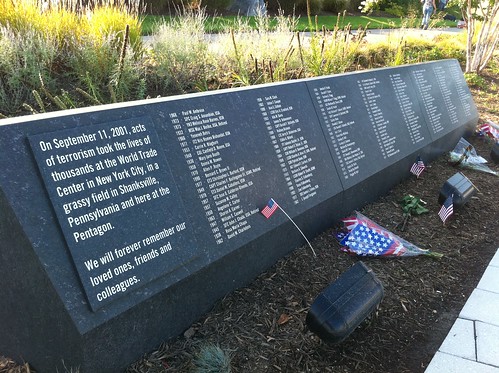
As you enter through the Memorial Gateway, visitors pass by a piece of limestone -- recovered from the Pentagon just days after the attack -- which is etched with the date and time of the attack.
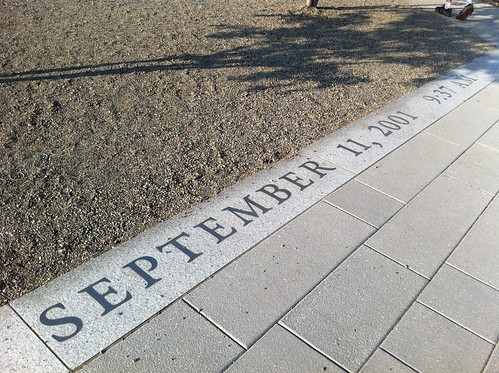
Also placed at the entrance to the memorial were several floral wreaths, given to us by our friends from other nations. Seen below is a gift from Japan.
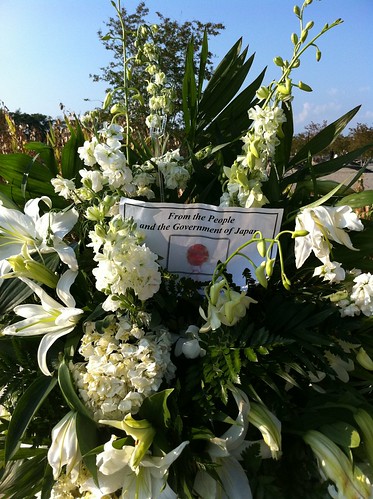
The memorial features 184 units, each with a cantilevered bench, a lighted pool of flowing water, and the name of the victim. It is a beautiful and moving site during the day, but I can only imagine how impactful it must be after sunset, as the units are designed to cast lit reflections of the water onto the bench and surrounding gravel.
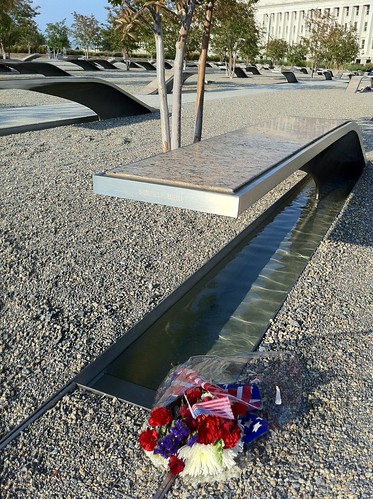
The Pentagon Memorial, designed by Julie Beckman and Keith Kaseman, was the first national memorial dedicated to the unthinkable tragedy that took place ten years ago.
On this day, as we've done nearly every day for the last decade, we remember the horrific events, mourn the innocent lives lost, and appreciate the freedoms and opportunities our nation affords us.
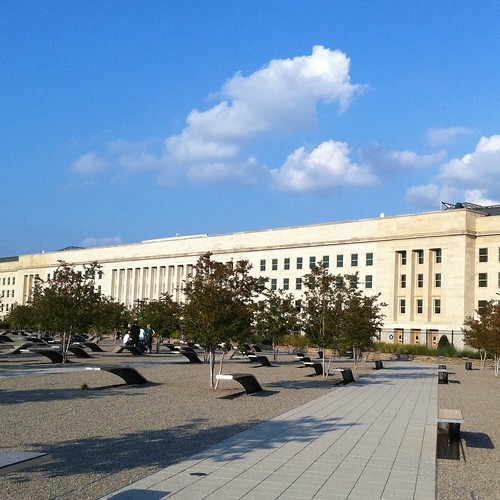
![]()
![]()